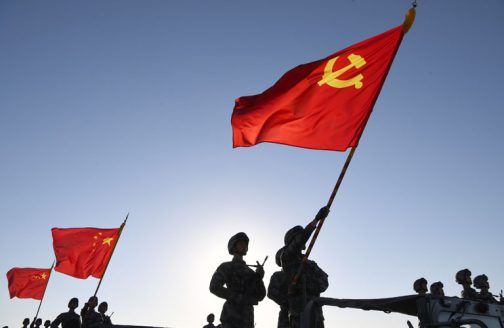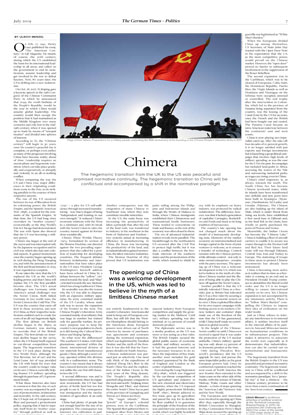Chimera: The hegemonic transition to China

The hegemonic transition from the UK to the US was peaceful and promised normative continuity. The hegemonic transition to China will be conflictual and accompanied by a shift in the normative paradigm.
On Feb. 17, 1941, Henry Luce published his essay, “The American Century,” in Life Magazine. He meant, of course, the 20th century, during which the US established the basis for its international leadership in all areas, and called on the government to end its isolationism, assume leadership and get involved in the war to defeat fascism. Now, 80 years later, the US is drifting into a new isolationism.
On Oct. 18, 2017, Xi Jinping gave a keynote speech at the 19th Congress of the Chinese Communist Party in which he announced that 2049, the 100th birthday of the People’s Republic, would be the year in which China would assume global leadership. The country would then occupy the position that it had maintained as the Middle Kingdom over many centuries and only lost in the mid- 19th century, when it was opened up to trade by means of “unequal treaties” and divided into spheres of interest.
According to Xi, the “Chinese century” will begin in 30 years, once his country’s peaceful rise is complete, or perhaps even earlier, as many of the prognoses involving China have become reality ahead of time. Leadership requires an ascent phase and hegemonic transition, which can take place gradually and cooperatively, or abruptly and violently in an all-or-nothing conflict.
When comparing the way the US and China rose, major differences in their originating conditions come to the fore, as do striking parallels in the courses of their respective ascents.
The rise of the US occurred between its war of liberation from its colonizing power, the British Empire, and the Spanish-American War (1898), a contest for the remnants of the Spanish Empire. At that time, the US had long since overtaken its “mother country” economically, as the 1893 World’s Fair in Chicago had demonstrated. The war with Spain also showed that the US was becoming a military power.
China’s rise began at the end of the 1920s and was interrupted only by the Japanese occupation and its civil war, which also had anti-colonial aspects. It gained momentum once the country began opening up in 1978 during the Deng Xiaoping era, and with the announcement of the Belt and Road Initiative in 2015, it was regarded as complete.
If one takes the view that the US replaced the UK as the world’s leading power, and that China will replace the US, the first parallels become clear. The UK’s actual challenger was Germany, while America’s actual challenger was the Soviet Union. Both failed; Germany in two world wars, the Soviet Union in the Cold War. The US was the country that came off best in those scenarios, and now it’s China, as their respective isolationism enabled each to evade the costs of an all-out hegemonic fight.
The first debate on British decline began in the 1890s, as German industry was starting to overtake that of the British Empire. The first debate on American decline began in the 1970s, when the US found itself exposed to cut-throat competition from Japan. The hegemonic transition to the US took place during the two World Wars, although the War Revenue Act of 1917 and the Lend-Lease Act of 1941 provided the UK with funds for wars that the country could no longer raise on its own. China is currently helping finance US military spending through its purchase of US government bonds.
What these histories also have in common is that the rise of each country was accompanied by policies of protectionism, isolationism and neutrality. In the 19th century, the US kept out of European conflicts and pursued a protectionist policy, arguing that it had to separate itself from its “mother country” through political as well as economic independence.
The Chinese analog to Hamilton’s Report on Manufactures (1791) – a plea for US self-sufficiency through increased manufacturing – was Mao’s slogan of being “independent and trusting in our own strength.” It reduced China’s economic relations with the West to a minimum and, with its break with the Soviet Union in 1960, the country turned against its former close socialist ally.
China’s Three Worlds Theory (1974) formulated its version of the Monroe Doctrine, one directed against the two prevailing superpowers that also called for a position of leadership for developing countries. The frequent debates between isolationists and internationalists that have taken place in the US since President George Washington’s farewell address have been echoed in China by a debate between the “yellow” (oriented towards the land) and “blue” (oriented towards the sea) factions, which has a long tradition in China.
Its neutrality was also the reason why the US was able to dispense with an expensive military apparatus. Its army consisted mainly of the US Cavalry, whose main task was to secure the expansion of the frontier to the west. The Chinese People’s Liberation Army consisted mainly of an infantry that was large in number but trained only for guerrilla warfare. Its primary purpose was to keep the country’s own population in check, as it did during the Cultural Revolution and Beijing Spring.
So what were the differences? The southern US states, with their plantations, operated within the classic international division of raw materials from manufactured goods. China, although a semi-colony, operated within this division only in a rudimentary sense. The country’s size meant that it always had a natural domestic orientation not unlike the one that still characterizes the US.
A second difference was and is factor endowment. Since its expansion westwards, the US has had plenty of fertile land but too few people to use it. The consequence was immigration and the mechanization of agriculture at an early stage.
China had plenty of people but not enough land for the size of its population. The consequence was intensive rice cultivation in paddies, which relied on manual labor to terrace and irrigate the fields and work them like small gardens.
Another consequence was the emigration of many Chinese to Southeast Asia, where they now constitute sizeable minorities.
In the US, the main focus was increasing the productivity of labor, a principle that, after the end of the land rush, was transferred to industry in the northeast in the form of Taylorism and Fordism – two systems aimed at increasing efficiency in manufacturing. In China, the focus was increasing the productivity of the land, and, as industrialization gained momentum, the labor-intensive industries.
The Monroe Doctrine of 1823 proved that US isolationism was not entirely fundamental to the country’s character. Americans did want to keep out of European conflicts, but still felt that the Western Hemisphere should belong to the Americans alone. European powers were driven out of North America by means of purchases, war, agreements and contracts during the westward expansion, which was legitimized by Manifest Destiny and the myth of the frontier; it was also felt that the Europeans should exit South America.
Chinese isolationism was pursued just as selectively. One need only think of the expeditions of Admiral Zheng He’s fleet in the South China Sea and the exploration of the Indian Ocean in the early years of the Ming dynasty. The People’s Republic also asserted Qing dynasty conquests in the west and north (Xinjiang, Inner Mongolia and Tibet) and claimed the entire South China Sea as part of the province of Guangdong and Taiwan as Chinese territory.
The “sugar islands,” those “jewels” of Europe’s colonial powers, were in the Caribbean. The Spanish fleet gathered there to transport silver from Mexico and Peru to Seville and to defend itself from pirates. The South China Sea was secure water for Chinese junks sailing among the Philippine and Indonesian islands and through the Straits of Malacca to India, where Chinese immigrants established their Chinatowns and transnational family businesses. These tended to concentrate on trade and finance, as the rest of the economy was often closed to them.
The era of advanced industrialization reveals more parallels. The breakthrough in the northeastern US occurred after the Civil War to protect high tariffs, but it was also a conflict between the free-trade interests of the southern states and the protectionism of the north, which wanted to shield its nascent industry from European competition and supply the growing market in the Midwest. Until 1917, military spending was also minimal, at 0.5 percent of overall domestic product.
The diplomatic service was in a similar position, as the US was more or less acting as a free-rider. The British Empire secured the global public assets of economic stability and military security, as it had the greatest interests and the necessary resources to do so. Since the imposition of free trade, another asset included the gold standard guaranteed by the Bank of England and London as the center of global finance.
Even during the Long Depression (1873–1896), which was triggered by the cut-throat competition of US agriculture and industry in the new chemical and electronics industries, when the US imposed the highly protectionist McKinley Tariff (1890), Britain adhered to free trade, gave up its agriculture and paved the way for its decline. Its fleet enabled it to guarantee the principle of the freedom of the seas and intervene anywhere in the world, which was highly beneficial to the US, especially in Asia.
China took a similar tack after 1949. Industrialization in the Mao era, with its emphasis on heavy industry, was protected by radical isolationism. The difference, however, was that it lacked a generation of capitalist Carnegies, Rockefellers and Fords and stuck to its long tradition of bureaucracy.
The country’s late opening has not changed much about the model of a bureaucratic developing state. Elements of the market economy are instrumentalized and foreign capital in the form of joint ventures is welcome, as it ensures a transfer of technology. Control remains with the Chinese partner, while ultimate control – not only in state-owned enterprises – remains with the party secretary. The opening up of China was a welcome development in the US, which was led to believe in the myth of a limitless Chinese market and the illusion of being able to play the Chinese off against the Soviet Union.
Another parallel is that the US initially tolerated China as a free-rider, just as Britain had tolerated the US as a free-rider by securing a liberal global economic system on its own. China exploited liberalism for its own export campaign while limiting access to its markets. Chinese tankers and container ships made use of the freedom of the seas that the US has guaranteed, while China itself made no contribution to global security.
At the height of the Chinese- Soviet conflict in 1968, China even received a signal that it was under the protection of the US nuclear umbrella. China’s military spending was only about 0.5 percent of its domestic product at the time.
Only during Theodore Roosevelt’s presidency did the US upgrade its navy and pursue the same imperialist policy as the great European powers had. Once its continental expansion reached the west coast of North America, the new frontier then extended to the Asian coast on the other side of the Pacific, with the seizure of Hawaii, Midway, Wake, Guam and other islands – a chain of stops spanning the “American Lake” between Asia and the New World.
The Europeans and Americans were involved in opening up China after 1842, especially through the British Concession in Shanghai. In 1853, Commodore Perry’s Black Ships alone secured the opening up of Japan. Spain sold the Philippines to the US in 1898 and the islands then had to be defended in a costly guerrilla war legitimized as “White Man’s Burden.”
When the Europeans divided China up among themselves, US Secretary of State John Hay reacted with the Open Door Note in the expectation that the US, as the most competitive power, would prevail on the Chinese market. However, the “open door” proved no barrier to subsequent involvement in the suppression of the Boxer Rebellion.
The second expansion was in the Caribbean, which was to be cleared of Europeans. Cuba, Haiti, the Dominican Republic, Puerto Rico, the Virgin Islands as well as Honduras and Nicaragua on the Isthmus were occupied, annexed or controlled. The real trophy after the intervention in Colombia, which led to the province of Panama being separated from the country, was the leasing of the Canal Zone by the US for 99 years, once the French and the British had been bought out and ousted. The Panama Canal became an intra-American waterway between the continents’ east and west coasts.
China is now playing neo-imperialist catch-up. After the take-off, four decades of 10-percent growth, it is no longer satisfied with just exports and foreign investments but is launching a geopolitical campaign that involves high levels of military spending, as was the case for the US in the past. Its campaign has included land-grabs in Africa, accessing the waters of the Nile and outsourcing industrial parks, as wages are rising, even in China.
China’s chief trajectory is, as always, towards the south. The South China Sea has become Chinese territorial water, while its islands have been transformed into airfields and new ports have been built in Kyaukpyu (Myanmar), Hambantota (Sri Lanka) and Gwadar (Pakistan). The Chinese are also building up the island of Male, which is under threat from rising sea levels, have established a first naval base in Djibouti and, as the final link in the chain, have wholly or partly purchased the ports of Piraeus and Venice.
Meanwhile, the Indian Ocean has become the “Chinese Lake.” China is building a fleet of aircraft carriers to enable it to secure sea routes through to the Persian Gulf and Red Sea. Their future land route will run through Pakistan, Central Asia, Iran and Turkey to Europe. The stationing of troops in these areas to protect Chinese investments has already been announced.
China is becoming more active as it realizes that its time as a free-rider is coming to an end and as President Donald Trump continues to destabilize the liberal world order and the US is no longer willing to ensure international security on its own. Yet, Chinese expansion is not accompanied by any missionary activity. There is no “Yellow Man’s Burden” compelling the Chinese to impose their idea of civilization on the wider world.
Just as China refuses to tolerate any interference in its internal affairs, it neither involves itself in the internal affairs of its partners in Asia and Africa nor insists on humanitarian conditions in its infrastructure projects. This makes it attractive to autocrats the world over, especially as it demonstrates that industrialization can also be carried out on authoritarian and bureaucratic terms.
The hegemonic transition from the British Empire to the US was peaceful and promised normative continuity. The hegemonic transition to China will be conflictual and accompanied by a shift in the normative paradigm. Yet a “peaceful rise” is but a chimera – the Chinese century promises to be more than a mere continuation of the American century.
Ulrich Menzel is professor emeritus of political science at the Technical University Braunschweig. In 2015, he published Die Ordnung der Welt (The order of the world), a 1,200-page study of the world’s great powers, that is already considered a standard work.
Ulrich Menzel
is professor emeritus of political science at the Technical University Braunschweig. In 2015, he published Die Ordnung der Welt (The order of the world), a 1,200-page study of the world’s great powers, that is already considered a standard work.




